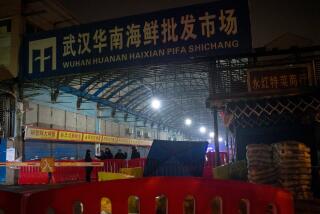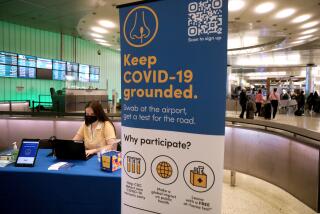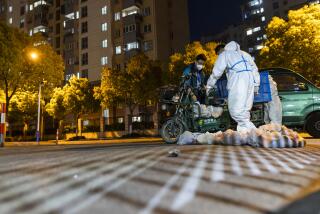Fear Goes Global
- Share via
The Tuesday night before last, I caught a transpacific flight out of LAX. The flight attendants were wearing face masks. So was I. This felt a little silly. It felt less silly when, changing planes in Taipei, a public health worker stuck thermometers in our ears after we got off the plane. We were nearing ground zero.
At the Hong Kong airport around 10 the next morning, only one baggage carousel was operating in the vast arrival hall. Hong Kong has been one of the locales hardest hit by severe acute respiratory syndrome, which is why I was there: to report on the effects of the virus. I saw one of them immediately. The airport, usually bustling and crowded, was virtually deserted.
SARS has now turned up in more than two dozen countries, clear proof that globalization has touched not only business and culture but also diseases. Through the first half of the last century, diseases moved slowly from continent to continent except in unusual circumstances, like when soldiers fighting in World War I carried the Spanish flu from the United States to Europe. Now microbes move quickly and easily around the world, an unfortunate byproduct of globalization.
Which is why all the airport taxi drivers were wearing masks. One of them took us to our plush but now reasonably priced -- and largely empty -- hotel, where masked personnel checked us in. I was beginning to wonder whether I was even supposed to sleep in my mask when a masked maid confided that the staff had been ordered to wear masks so as not to scare any guests who might have become afraid of naked faces.
The local fixer we’d hired escorted us to an area of shops to do some interviews. A lot of people were on the streets, about half of them masked, many of them young, because school closures were going into the third week.
It was beginning to feel as if we were in a low-budget science fiction movie. There were minimal special effects -- cheap surgical masks -- and a monster that you couldn’t see: the virus. Even without a menacing soundtrack, it was hard to escape the sense that something was out there. Lurking. Waiting to attack.
We began stopping passersby. Some of them told us that they were worried. Others said that they weren’t. Some of those not wearing masks said that they wore them when they went on public transport. Almost no one knew anyone who’d gotten sick. I started doing the math in my head. By this point, Hong Kong, with a population of 7 million people, had confirmed around 1,500 cases of SARS, with 60 or so deaths. That meant fewer than one in 4,000 had gotten the disease, which seemed comforting.
The local evening news shows restored my level of fear. They all led with the casualty count, reminiscent of a sports or financial run-down: four more dead, 31 new cases. In Hong Kong, complacency alternates with fear.
The next day, we visited the Amoy Gardens apartment complex, a cluster of 30-story towers where 321 people -- more than one-fifth of those who had then been afflicted in Hong Kong -- came down with SARS. The event was traced to a single infected resident and a faulty plumbing line attached to the toilet he used. Four women in tall rubber boots were using hoses and mops on the plaza shared by the buildings. The area stank of bleach. In the cab driving away, we bathed in antibacterial lotion.
But that evening, in the plush shopping mall attached to our hotel, we ventured out maskless -- as did almost all the other shoppers. It was as if Hong Kong had decided that wealth confers a certain immunity to SARS.
Our ultimate goal was to cross the border to mainland China, to the city of Guangzhou, capital of Guangdong province and supposedly the birthplace of SARS. It first appeared there last November, eventually resulting in more than 1,000 cases in the area -- a fact Chinese officials apparently tried to cover up.
Our fixer was nervous about the trip, so we decided to load a van with food and water, drive in, shoot some interviews and get out the same day. But when we got to Guangzhou, we were the only ones wearing face masks. We stopped a few passersby to ask them why they weren’t wearing masks. They seemed puzzled at the question. The danger, they said, wasn’t very big here.
But with our face masks and Hong Kong license plate, we were scaring some of them. Some people covered their mouths and turned their faces as they walked past us. The government media evidently hadn’t told them much about SARS in Guangdong, but they knew about the disease in Hong Kong.
We headed to the Guangzhou Trade Fair, a twice-yearly exposition that last year reportedly accounted for 14% of China’s total export deals. Here too we seemed to be the only ones in face masks, possibly because we seemed to be the only foreigners. The exhibitors said they weren’t seeing any customers. Some hadn’t seen any all day. “Why is that?” we asked. “You know,” we were told, “you are wearing masks.” They didn’t want to use the word SARS, but obviously their absent foreign customers had already heard it.
The day after our visit, China’s top health official was fired, and the Chinese government declared a campaign of openness about SARS, thereby illustrating a second SARS-related byproduct of globalization: The need to continue doing business prods governments to be more open.
But as China’s media get the green light to start their own SARS blitz, we might see a third byproduct: As the world globalizes, so does panic. Perhaps we’re already seeing it. The day of our departure for Hong Kong, my colleague and I visited eight L.A.-area pharmacies between us before finding one that had not sold out of face masks.
More to Read
Sign up for The Wild
We’ll help you find the best places to hike, bike and run, as well as the perfect silent spots for meditation and yoga.
You may occasionally receive promotional content from the Los Angeles Times.






